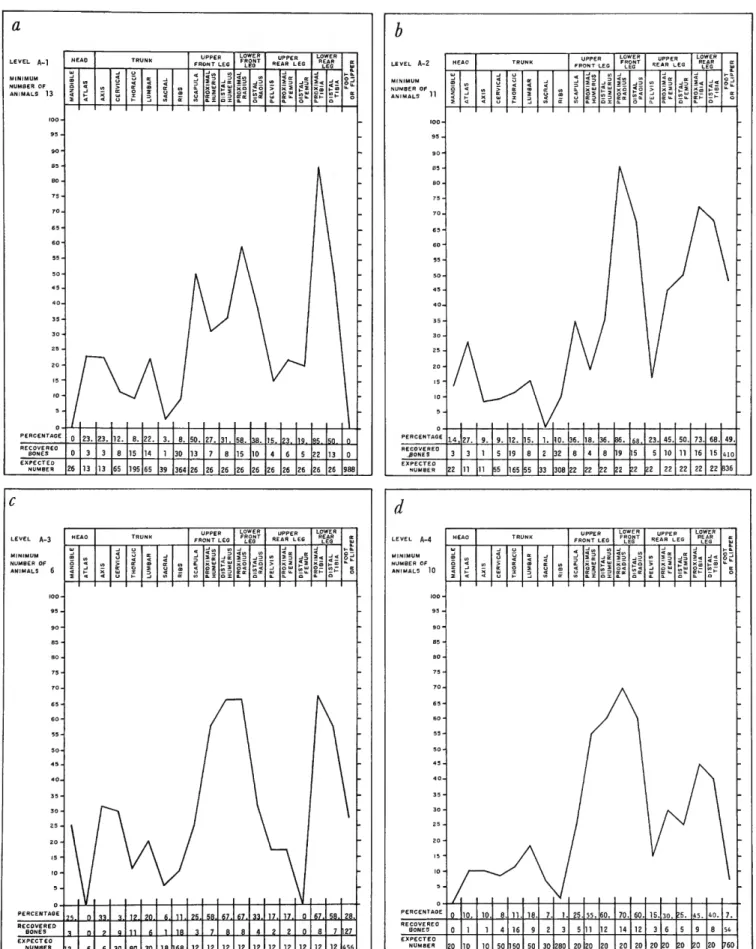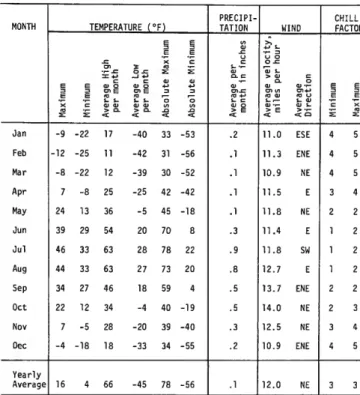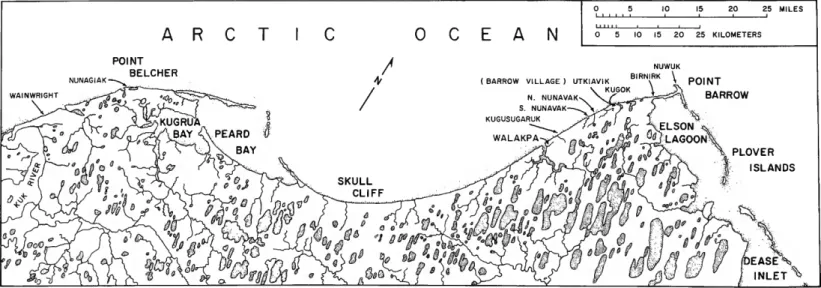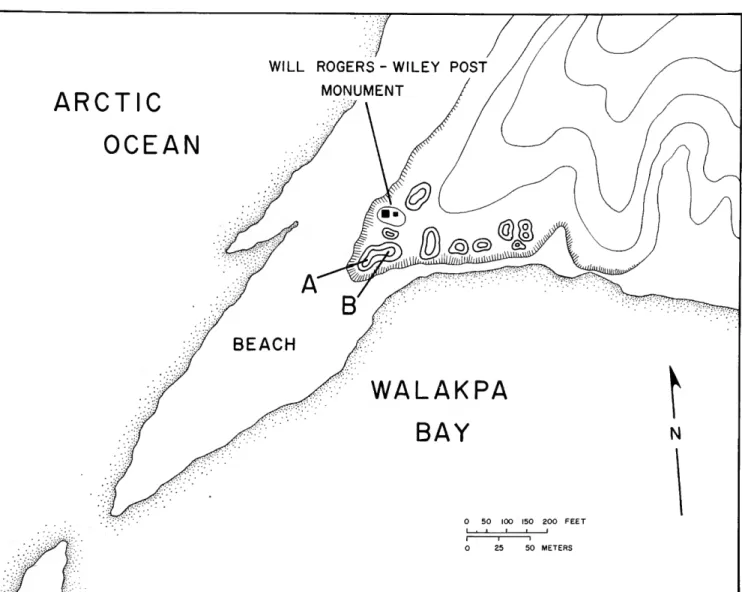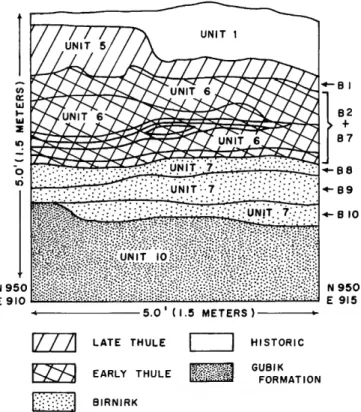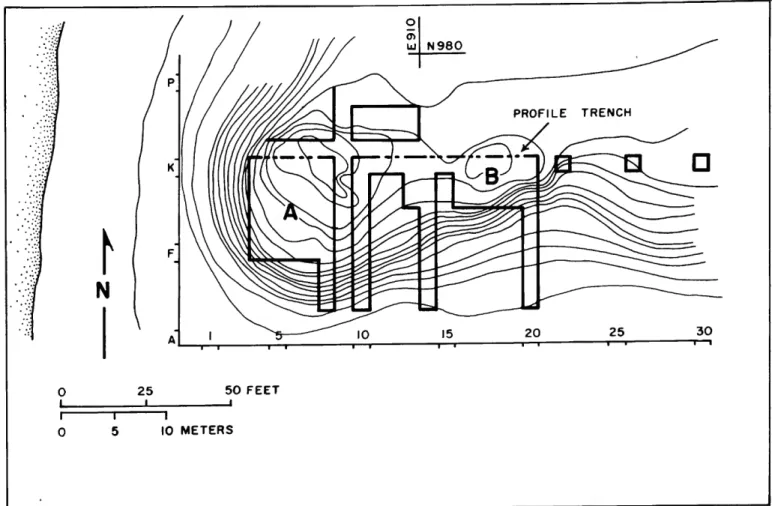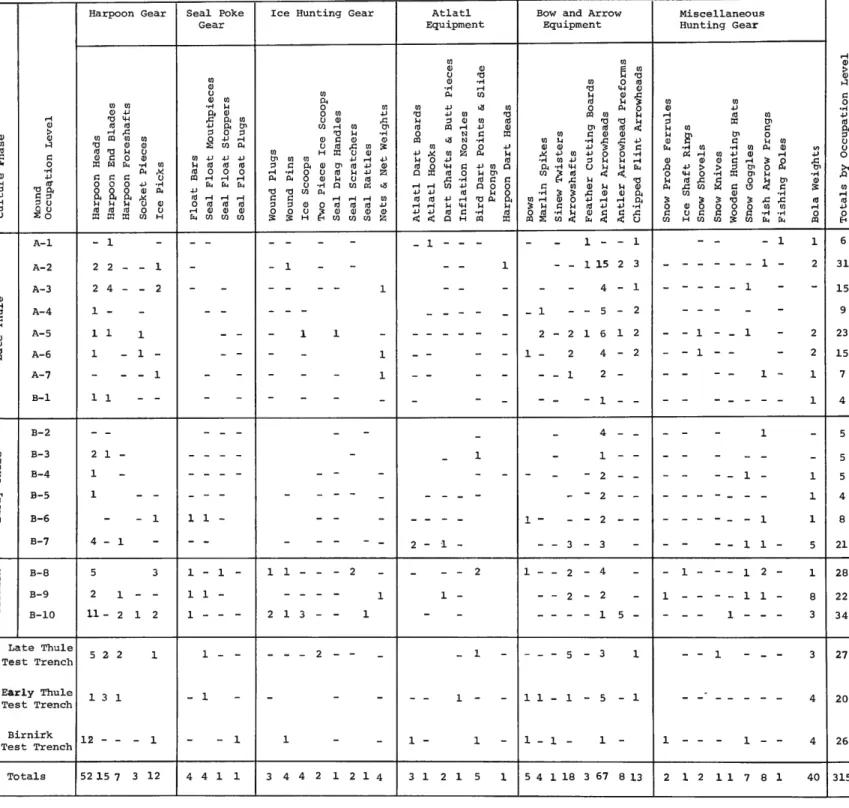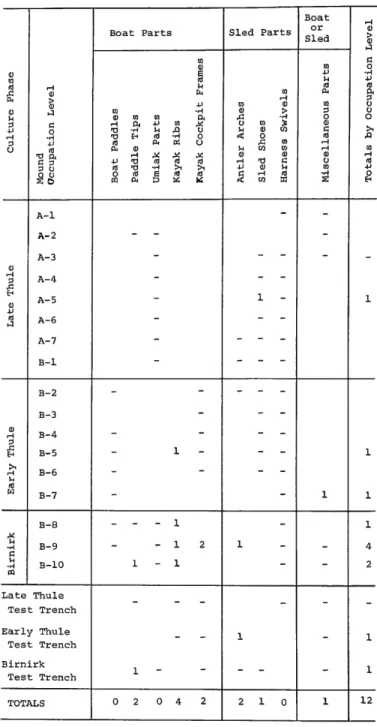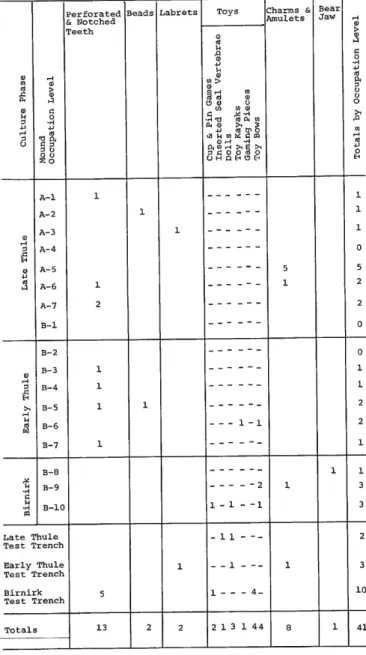It is for this reason that not all artifacts described in the text are illustrated. James Duguid of Princeton University, who worked on the geology of the Walakpa Bay area; Remains of the arctic fox (Alopex lagopus) and the wolf. Canis lupus) are found in the fauna collection.
As far as I could ascertain, none of the waters in the Walakpa area contain fish. T he Walakpa stratigraphy was defined on the basis of the 1968 test trenches and the 1969 excavations.
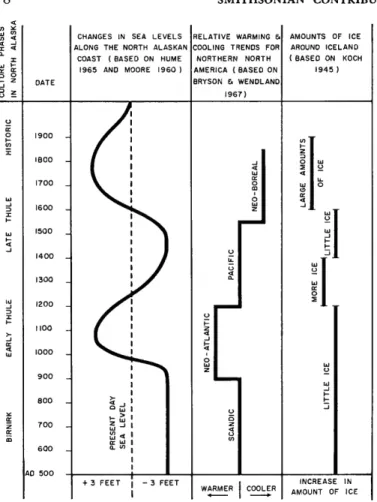
ARCTIC OCEAN
Adzes
These are wooden blocks that are pointed at both ends and carved to fit in the palm of your hand. The larger specimen, measuring 20 cm in length and 4.2 cm in width, has two holes, both placed closer to one end than the other (Plate 25?). Eight specimens of ribbed blades were found in the Walakpa collections, six in the Birnirk levels, and two in the late Thule levels.
There appear to be five types of mattock blades, based on the method of attaching the blade to the handle. In the Birnirk specimens there are three examples with three points and no connecting channels (Plates 40a, 41c). The latter specimen has an additional hole drilled into the ventral surface, apparently for the insertion of an additional retainer between the blade and handle.
In all cases the ventral surface is roughened to create a surface on which to attach the handle to the blade. These are picks made of small, narrow ribs that end in a sharp point, instead of the broad blade of the picks. The other Birnirk example is 42.2 cm long and made from a whale rib split in two (Plate 416).
It is 9.9 cm wide at the articulatory tip, while at the end of the handle it is 4.4 cm wide. Large wedges are quite wide at the tip and shank compared to the smaller variety. One of the Birnirk specimens was made from a broken mattock blade and had a whole drilled into the side.
Ulus
T he backs of the blades are dressed to match the handle by peeling off a square tang near the center of the dorsal edge. One of the late D u l e specimens has a hole drilled into the tang, probably to attach the blade to the handle. The main difference between the side and end scrapers is that the side scrapers have resharpened one or both sides of the longitudinal axis of the flake while the end scrapers have retouched and used on the distal end of the flake.
Ford would probably have attributed the rarity of plano-convex scrapers to the exclusive use of the beam tool. However, it does not have the fine dorsal and ventral touch of the common eskimo scraper. The rest of the side scrapers found in the Late T h u l e tool set do not appear in either Early T h u l e or Birnirk levels at Walakpa.
These scrapers range in size from 4.5 to 2.1 cm, measured from the scraping surface to the trailing edge of the artifact. At the end of the scraping surface of one specimen is a sharp point, which was probably used as an engraver (plate 52g). These are quartz pebbles that have been split in half and flaked off along the edges of the broken surface.
The top and one side of the artifact are scarred from being used as a hammer to crush hard substances. Two examples from the Early T h u l e occupation are of a variety that has been split down the middle of the shaft. The proximal end of the shaft was broken to produce a shelled rim, and the rim surfaces are worn and polished from use.
Hide Pegs
This shard is one of the thinnest, measuring 0.8cm, and looks better made than the other examples. The braces are attached to the bottom with baleen cords that pass through holes drilled on either side of each end of the brace. The inner surface of the bottom strap appears to be grooved to attach the bottom.
The strips are tied together by two sets of laces on either side of the bucket. At the top of the container, holes have been drilled on two sides for handle attachments. Both strips overlap at the ends and have two laces on the sides of the walls.
The connection runs directly from below the edge of the handle to 2 cm from the bottom of the shaft. The cutting edge of the tail has a flat surface cut from the bone at an angle of 33%. They are round in cross-section with little modification of the bone except for the sharpening of the tip.
In those cases where they are not, wear is present throughout the diameter of the point. A Birnirk example has been resharpened and comes in a short point, which is moved to one side of the tool. On the opposite side of the hole, there is a long, wide, concave groove, which is probably a finger rest.
COMMUNITY ACTIVITY ARTIFACTS AND EQUIPMENT
T he shape and size of this groove will perfectly fit the shank of a measuring drill. T h e proximal end is offset from the shoulder, producing a pincer that will rest between the t u m b and the index finger.
Beads
Pebble End Scrapers Flat Convex End Scrapers Side Scrapers Split Pebble Scrapers Handle Scrapers Two-Handed Scrapers Bone Scrapers.
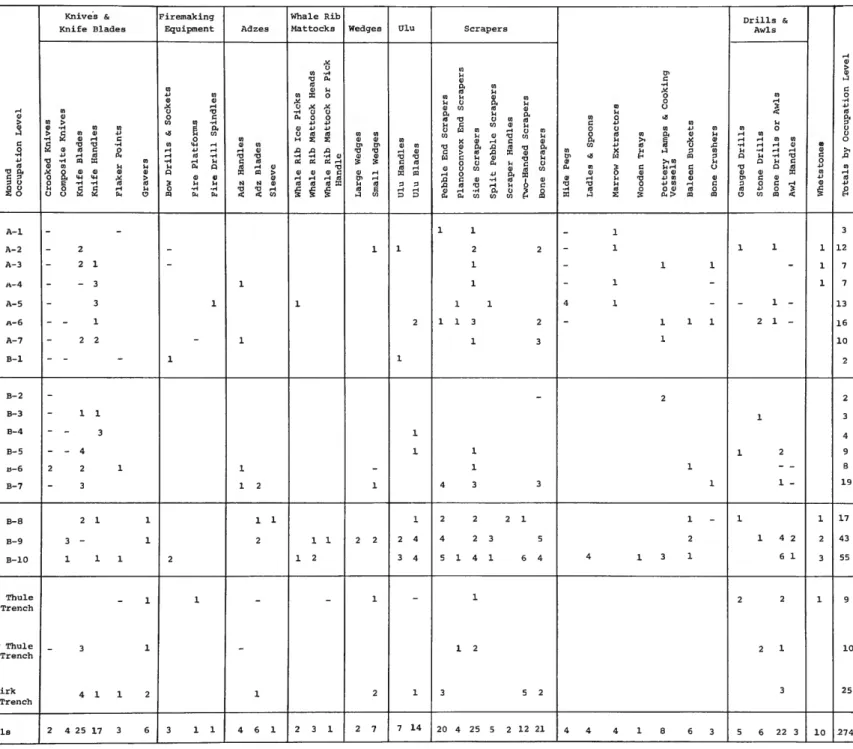
Toys
Severed bone and antler squares were found in all periods at the Walakpa site (Plates 12g-/, I05h). I suggest that they are probably buttons because an example from a historic level at Walakpa has two rectangular openings cut into the center. However, if this is true, it is puzzling that more finished samples do not occur at other levels.
T he wing section has a large wedge cut to articulate with the next piece of the arch. T he most beautiful effigy found at Walakpa was that of an ivory polar bear (Plate 60a-/). Since the legs of the bear are carved so that the front legs meet and the hind legs are grooved, the carving is thought to be part of a composite tool.
The lines are connected with short 0.2 cm lines, two pairs close to the back and front of the animal's body. On each side of the holes there are also two short lines connecting the main lines. Below the main lines and the insertion holes are two short lines, which are doubled at the ends.
The ivory chosen for the carving has a dark spot, which is placed on the tip of the snout to give it a realistic color. Although relatively larger, they are believed to be related to the caribou and may represent some form of sympathetic magic. The feather, which is split in the middle but not at the end, is still attached to the arrow shaft.
One of the most interesting is a thin piece of ivory with a small open hole in the center (Plate 36b). Near the top of the curve, a slight nipple with a shallow cut in the center is left at one end. Two short lines run from the tips of the scallops towards the center of the object.
Notches are carved on one edge and one on each side of the pointed edge. The discoloration on this edge of the artifact indicates that it has been attached around the bevel. The distal end of the artifact is blade-like, with its widest part near the blunt tip.
The diameter of the largest expansion point is 1.8 cm, while the diameter of the narrow end of the shaft is 1.2 cm. It is cut flat on one side, while the rest of the artifact is rounded. That end of the hook is notched and tied back to the main strip with a bale line.
No reference skeletal material was available for whales at the time of the study. The classification used (juvenile, adult or old) was based on a subjective examination of the degree of tooth wear. MEASUREMENTS WITH LONG BONE STAMPS. McLaren has pointed out that the size of seals is directly proportional to the length of the seal pup's suckling period.
Articular s Length
Distal Condylar
Axis
Distal
Condylar Width
Notch Length
Condyle Axis
Diaphyseal Length
The analysis of the horizontal distribution of the bones in the different levels was not very useful. Thirty-three to 58 percent of the skulls from the m i n i m u m n u m b e r of seals killed were found in the base camp levels. These options are summarized in the discussion of the season round and in Figure 1.
Many of the types mentioned above are only found at the historic levels in Walakpa. Of the harpoon heads found in Walakpa, only one type was not found in Utkiavik. The antler arrowheads found in these mounds were of the round-shouldered, conical tang variety.
However, all phases contain harpoon heads in the cultural inventory, which can be compared to the Late Thule cultures of the northern coast. This type of harpoon point is very close to the Oopik open-socket harpoon head of the Early Birnirk. T h e antler arrowheads of this level are of the Birnirk and Early T h u l e varieties and not Punuk.
These types of harpoon heads did not occur at Walakpa, but were found in m o u n d A of the Birnirk site and should be considered late Birnirk in age. Taylor felt that the harpoon head is of the Natchuk type and suggests an early age. It is also possible that the Ipiutak culture of Point Hope may have contributed to the development of the Birnirk culture.
During Late Birnirk, Naulock, along with most of the other Birnirk harpoon heads, lost 111.
